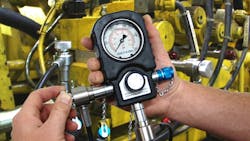Hydraulic-Injection Injury: Insidious, Potentially Devastating
Editor's note: This article has been updated. It was originally published in 2014.
“The Lethal Strike.” So named is a video enactment about a shop technician who incurs an injection of hydraulic fluid at the base of his finger when investigating a leak in a wheel loader (see below). Although a needle-like stream of hydraulic fluid penetrated his hand when he was feeling his way through a bundle of hoses across the loader’s articulation point, the technician is not certain what happened, other than “it felt as if something bit me.”
Produced by the Fluid Power Safety Institute (FPSI), the video on hydraulic oil safety goes on to depict an incorrect diagnosis at the hospital emergency room shortly after the mishap. The ER attendant—suggesting that the small, innocuous-looking puncture wound in the technician’s hand was likely made by a wire protruding from a frayed hose—prescribes antibiotics and pain medication. Experiencing only moderate pain in his hand, the technician returns home.
While our technician is returning home, a couple of real-life experts explain the nature and seriousness of his hydraulic injection injury. Gary Kleiner, training and development manager for Parker Hannifin’s Fluid Connectors Group, and Doug Honig, marketing services manager for the company’s Hose Products Division, are involved in Parker Hannifin’s SafetyWorks program, which promotes awareness of following proper practices and maintaining safe conditions with regard to fluid systems. They have this to say about high-pressure-injection injuries in a recent Parker Safety Solutions bulletin:
“Pressurized fluids travel at bullet speed and can penetrate deep under the skin. The injured person may feel only a slight ‘electric shock’ or pricking sensation. Rarely does the initial pain indicate the actual severity of the injury. What looks like a simple puncture wound is, in fact, life threatening.”
Douglas Carlan, M.D., specializing in surgery of the hand and upper extremities at Eaton Orthopaedics in St. Petersburg, Fla., says his practice typically sees a couple of cases of hydraulic injection injury each year.
“Overall, we don’t see a high incidence of this type of injury,” says Dr. Carlan, “but it tends to be a devastating injury when we do see it.”
Read also: Hydraulic Fluid Basics: Formulation, Selection, Maintenance
Back at home, the injured technician is awakened by excruciating pain at 3:30 in the morning and sees that his hand is now severely swollen and inflamed, with dark discoloration in his index and middle fingers. Back at the hospital, the ER attendant, recognizing that the situation has turned critical, immediately calls in a hand surgeon. The surgeon kindly but honestly tells the technician that blood supply in at least two fingers has been compromised, and that amputation of one finger is sure, a second possible—at best.
“The Lethal Strike” concludes: “Oil-injection-injuries of the hand are not common, but occur with enough frequency—and the consequences of mismanaging them are so serious—that victims, supervisors, emergency medical personnel, and primary care physicians must be able to diagnose them. The outcome of the injury is dependent on the type, amount and velocity of the material injected; site of injection; and the prompt and appropriate management of the injury.”
Rory McLaren, founder and director of the FPSI, admits that the available evidence indicates that high-pressure-injection injuries are few and far between, but he also believes the evidence might not accurately reflect the reality of the situation.
“According to an FPSI study,” he says, “more than 99 percent of people who service, repair, and troubleshoot hydraulic systems have been subjected to the exact dynamics that trigger a high-pressure-injection injury. The ‘liquid bullet,’ however, either missed or deflected off its target. If ‘hydraulics’ were a recognized occupational hazard, and thus fell into a category for near-miss reporting, we would be at catastrophic levels.”
Points of oil injection danger
Danger from other fluids
Of course, technicians working in equipment shops or from field-service trucks are at risk for hydraulic injection injuries from more sources than mobile hydraulic systems. For instance, common-rail fuel systems in today’s machines operate at pressures exceeding 30,000 psi, and high-pressure paint guns and pressure washers with detergents are routinely used for equipment maintenance.
“But don’t be misled,” says McLaren. “Injection can occur at pressures as low as 100 psi. It’s all about how and where the injury is sustained. And there currently is no hand protection available to prevent an oil-injection injury—that is, nothing you could wear and still be able to work.”
Mark Otto—an instructor for Local 150’s (International Union of Operating Engineers) Apprenticeship and Skill Improvement Program (ASIP) at the Local’s Wilmington, Ill., training facility—says that he once observed an experiment, conducted by an equipment manufacturer under controlled conditions, in which a stream of hydraulic oil at 3,000 psi was directed through an orifice and aimed at a welding glove. On average, he says, the fluid stream penetrated the glove three out of five times.
When working with hydraulic systems, says McLaren, injection injuries can occur from a pinhole leak in a line: “People routinely run their hands across a hydraulic line suspected of leaking, and seeing nothing, they start ramping up the pressure to encourage the leak.”
Injury also can occur, says McLaren, when technicians attempt to open or tighten lines, perhaps to install components or to bleed air from cylinders, the latter practice, he says, being both dangerous and environmentally unsound.
“Because hydraulic systems do not have to comply with OSHA’s lockout standard with respect to de-energizing and verification,” says McLaren, “injuries are caused when technicians crack open lines, not realizing there is stored energy in the line. Or, they may attempt to tighten a fitting under pressure, reasoning that ‘as I tighten it, I’ll see when it stops leaking.’ But if you’re tightening a metal-to-metal seal, you risk cracking or splitting it and releasing the fluid to atmosphere.”
Read also: How to Defend Hydraulics from Dangerous Contaminants
Manuals from most equipment manufacturers caution that escaping fluid can penetrate the skin and cause serious injury, emphasizing that all pressure must be relieved before disconnecting high-pressure lines. But specific instructions about how to effectively dissipate pressures—and how to verify depressurization—often are lacking.
According to McLaren, hydraulic oil systems have a nasty way of retaining pockets of high pressure, even after the pump shuts down and control levers are cycled to dissipate residual pressure. He makes the point that there is no widely used device in the fluid power industry that can, like an voltmeter, be used to test if a line is dead (depressurized).
How hydraulic injection injuries damage
The damage caused by hydraulic oil or other toxic fluids injected into a hand or forearm results from several sources. The first is simply the force of the injectate (the material injected).
“The process of injecting at high pressure will damage tissue on the way in,” says Dr. Carlan. “It’s almost like being shot with a gun. There’s a path the injectate follows and soft tissue will be damaged along the way.”
Damage of a more insidious nature, however, says Dr. Carlan, results from two primary sources: the chemical composition of the injectate and the subsequent pressure the injectate causes when it enters one or more of the many “compartments” in the hand or arm. (When a tough, fibrous sheath of tissue, or fascia, tightly surrounds structures such as tendons and muscles, a “compartment” results.)
Read also: Defend Your Hydraulics from Dangerous Contaminants
Some injectates are extremely caustic and cause tissue to quickly die. The longer the injury remains untreated, the farther through the fingers, hand, wrist and forearm the injectate can migrate and the more compartments it will invade. A frequent subsequent complication is infection resulting from bacteria in the necrotic tissue.
“The hand and forearm are incredibly complex with compartments,” says Dr. Steven Marcus, who served as executive director and medical director of the New Jersey Poison Informatation and Education System until 2016. “The fluid can spread from the injection site quickly and reach many compartments.”
The second major source of damage results from pressure buildup within compartments in the hand and forearm, a condition generally known as “compartment syndrome.” Since the fascia is tough and does not expand, the volume of injectate (and any consequent swelling) can cause pressure to build up in the compartment, like over-inflating a balloon, says Dr. Carlan. The pressure damages tendons, arteries, vessels, nerves and muscles.
“The pressure caused by the fluid injected can overwhelm the blood supply if the pressure [in the compartment] is greater than the arterial pressure,” says Dr. Carlan. “You lose circulation in the compartment, and unless you get in there quickly and open it up to relieve the pressure, you risk losing the digit from lack of blood supply.”
Depressurizing the hydraulic system
How to treat an injection injury
“We never say ‘always,’ but we typically consider injection injuries a surgical emergency,” says Dr. Carlan. “This is something we take immediately to the operating room to relieve the pressure [in the compartments] and to remove as much of the injectate as possible. We then debride the area by removing necrotic tissue back to viable tissue.
“Typically we would leave the wound open to reduce the prospect of infection and further tissue damage, then plan to go back to the operating room the next day, or within 48 hours, for a second look for damaged tissue and foreign matter. The wound might then be closed, unless swelling prevents it.
“A secondary problem is that fingers often get stiff and painful and might require additional procedures for freeing tendons or improving flexation of the digit. I’ve sometimes gone back and amputated the digit, because it’s just not working.”
So now that we know what can happen and what we might be in for if it does, can the risk for hydraulic injection injury be minimized?
People who work on mobile hydraulic systems are at risk on two fronts—first, when investigating leaks, especially when the leaks are not readily visible, and then when opening a system to make repairs.
The Fluid Power Safety Institute’s copyrighted “Pressurized-System Safety” publication provides recommended best practices for investigating and repairing hydraulic leaks in flexible hose, steel tubing and steel pipe, both when leaks are visible and not visible.
In the section discussing “Procedures/Guidelines for detecting leaks in flexible hydraulic hose if the leak is not visible,” the FPSI recommends that appropriate personal-protection equipment be worn, including safety glasses and a full-face shield; that the machine be “locked-out” in accordance with company policy; and that the technician should “identify all zones of potential stored energy and systematically de-energize each zone,” then “verify that each zone is completely de-energized before loosening any connectors.”
So now that we know what can happen and what we might be in for if it does, can the risk for hydraulic injection injury be minimized?
Read also: Safety Sleeves for Hydraulic Hose Failures
People who work on mobile hydraulic systems are at risk on two fronts—first, when investigating leaks, especially when the leaks are not readily visible, and then when opening a system to make repairs.
The Fluid Power Safety Institute’s copyrighted “Pressurized-System Safety” publication provides recommended best practices for investigating and repairing hydraulic leaks in flexible hose, steel tubing and steel pipe, both when leaks are visible and not visible.
In the section discussing “Procedures/Guidelines for detecting leaks in flexible hydraulic hose if the leak is not visible,” the FPSI recommends that appropriate personal-protection equipment be worn, including safety glasses and a full-face shield; that the machine be “locked-out” in accordance with company policy; and that the technician should “identify all zones of potential stored energy and systematically de-energize each zone,” then “verify that each zone is completely de-energized before loosening any connectors.”
Once these precautions are observed, the technician, wearing gloves to protect hands from protruding wires, can safety run hands across hoses looking for worn spots and potential leak points.
If this procedure fails to find the leak, say in a bundle of hoses, then, if safe to do so, the FPSI guidelines recommend that the machine be started and that each hydraulic circuit represented in the hose bundle, in turn, be “stalled” (for example, by bottoming a cylinder in its extend position, then, in the next test, in its retracted position). After each test, determine if leakage has increased by observing if the pool of oil under the suspect area has become larger. If so, then the last hose tested is likely the one leaking, but it can be replaced only after observing the strict depressurization procedure. If this test is not conclusive, then the FPSI recommends checking individual hoses with a proprietary test instrument (Hydra-Check Portable MicroLeak Detection Kit).
The real challenge is to make sure that all potential zones of stored energy have been neutralized. In our investigation, only one such system designed for this purpose came to light, the Safe-T-Bleed system developed by the FPSI. But unless a machine is equipped with this system (or perhaps a manufacturer’s proprietary system that escaped our notice), the risk of encountering residual pressure when opening the system remains.
So, where to go from here? You know what “conventional wisdom” advises: Be thoroughly familiar with the system you’re working on—accounting for accumulators or holding valves that could store energy. Determine if the machine’s electro-hydraulic control levers can be cycled to relieve pressure if the ignition key is off. Be careful to lower implements to the ground to relieve cylinder pressures before working on the system. Never pass your hand across a line or tube when investigating a non-visible leak; use a piece of cardboard or wood to intercept the fluid stream, with your hand well away from the hose.
Be aware, however, that observing these precautions, well intentioned as they are, will guarantee neither that the system has been completely depressurized, nor your absolute safety.
Be prepared for hydraulic injection injuries
Companies whose employees are at risk from hydraulic-injection injuries should determine that local hospital emergency rooms are familiar with the serious nature of such injuries, and that a hand surgeon familiar with treating these injuries can be reached. Most experts advise, too, not to waste time visiting non-hospital emergency care centers.
The FPSI recommends that no tourniquet be applied to the victim and that the victim be given no food or drink in anticipation of immediate surgery. Also suggested is to have ready a “Dear Doctor” letter that provides the details of the injury (when, type of fluid, pressure) and also, if possible, an MSDS (material safety data sheet) for the material injected. Above all, says the FPSI, remember that prompt treatment is critical.
Dean Black, technical instructor in Local 150’s Apprenticeship and Skill Improvement Program, has a final thought: “Mechanics are always cutting their hands and suffering what seem to be minor abrasions, and it’s easy to ignore these wounds. But don’t ignore any wound that appears to be a puncture, even though slight, especially if you’ve been working around a leaking hydraulic system or other type of pressurized system.”


